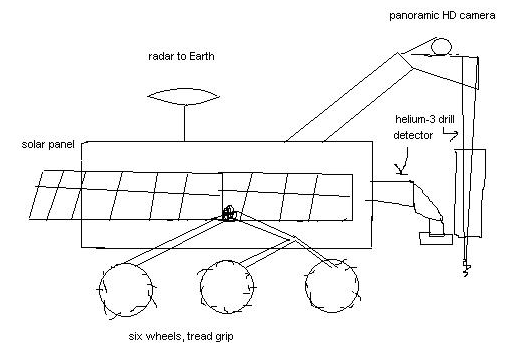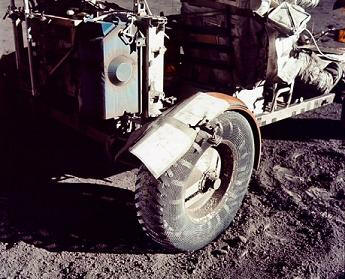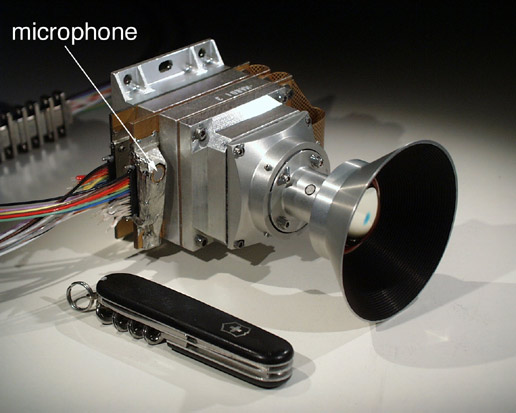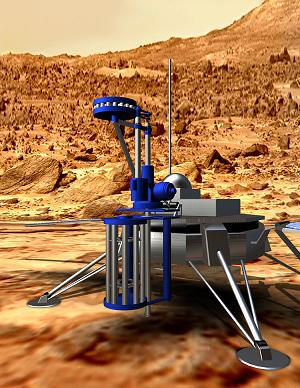|
Lockheed Martin Exploring Program Post 1010 Botball Research Project |
|||||
|
The robot will similar in design to the Mars Rover designed by NASA for
the Mars Exploration Rover Mission. Is will implement six
independently controlled wheels for movement. It will also be
equipped with two static dischargers which use a tungsten needle to
ionize compressed air which is then released periodically onto surfaces
which could become covered in dust. This will prevent camera
lenses and other surfaces from becoming obscured and prevent overheating. The Rover will also be equipped with a high power
drill which penetrate the lunar surface in search of helium-3.
Once a hole has been created a detector containing an organic compound
with a high energy emission will emit electromagnetic radiation of a
frequency equal to or higher than UV light.
Wheels
Navigation Our robot will mainly rely on daytime commands relayed directly from Earth, such as movement coordinates and drill locations. Our rover will also house onboard AI navigation that will allow it to: 1) retrace its steps if it suddenly loses signal 2) determine whether it should go over or around a rock in its path This system will help the rover find its way back to the launch pad in case it gets lost or has a communication error. At nighttime, when our rover cannot receive commands from Earth, it will stop all tasks and go into standby to conserve power. In the morning, it will automatically "wake up" and await further instructions from the Earth command. Once it drives 500 meters to the appropriate open field, our rover will initiate its spiral search program, which will allow it to thoroughly navigate the area and safely drill. Power We have decided to use one SN-185 model solar panel from Max Energy. It will cost roughly $1100 and weight 85 lbs, but with a power output of 185W, it should generate more than enough power for our entire robot [6]. Unlike Mars, where solar winds are able to clear the solar panels of Spirit and Opportunity of dust, lunar dust is much harder to remove. Therefore, we will implement Panasonic's ER-VW Static Ionizer to discharge our rover's solar panel, at a cost of $1300 [11]. It will be fired once every hour to ensure that our solar panels function with maximum efficiency [12]. Mass Our rover is going to be built out of CNC machined titanium. Since the two Mars exploration rovers weighed roughly 400 lbs. [5], with our added weight on the drill (but a reduced weight on the solar panels), we hope to aim for under 450 lbs. Camera
Drill We have decided to use the CanaDrill developed by the Northern Centre for Advanced Technology and Electric Vehicle Controllers [8]. Originally designed to be used in NASA's 2009 Mars mission, this instrument was designed for rugged space exploration, and will be durable enough for us to conduct multiple lunar drills.
Detection The detection of the helium-3 isotope involves the use of titanium dioxide as a photocatalyst. He-3 is found near TiO2 on the nearside of the moon. When exposed to electromagnetic radiation of a frequency greater than that of Ultraviolet radiation (greater than 7.15 x 1014 s-1) [17], TiO2 reacts, oxidizing any organic substance in the vicinity. The detector would contain a gamma radiation emitter which would use a radiation source such as I-131 or Tc-99 contained inside a lead box which would release bursts of radiation when commanded to. The detector would use gamma radiation because of its ability to permeate most materials. The gamma rays would activate the catalysis of the TiO2. Any TiO2 in the area would then oxidize a solution of an organic material, giving off a charge which would be detected and used to indicate the proximity of TiO2. 
|
|||||



 [9]
[9]